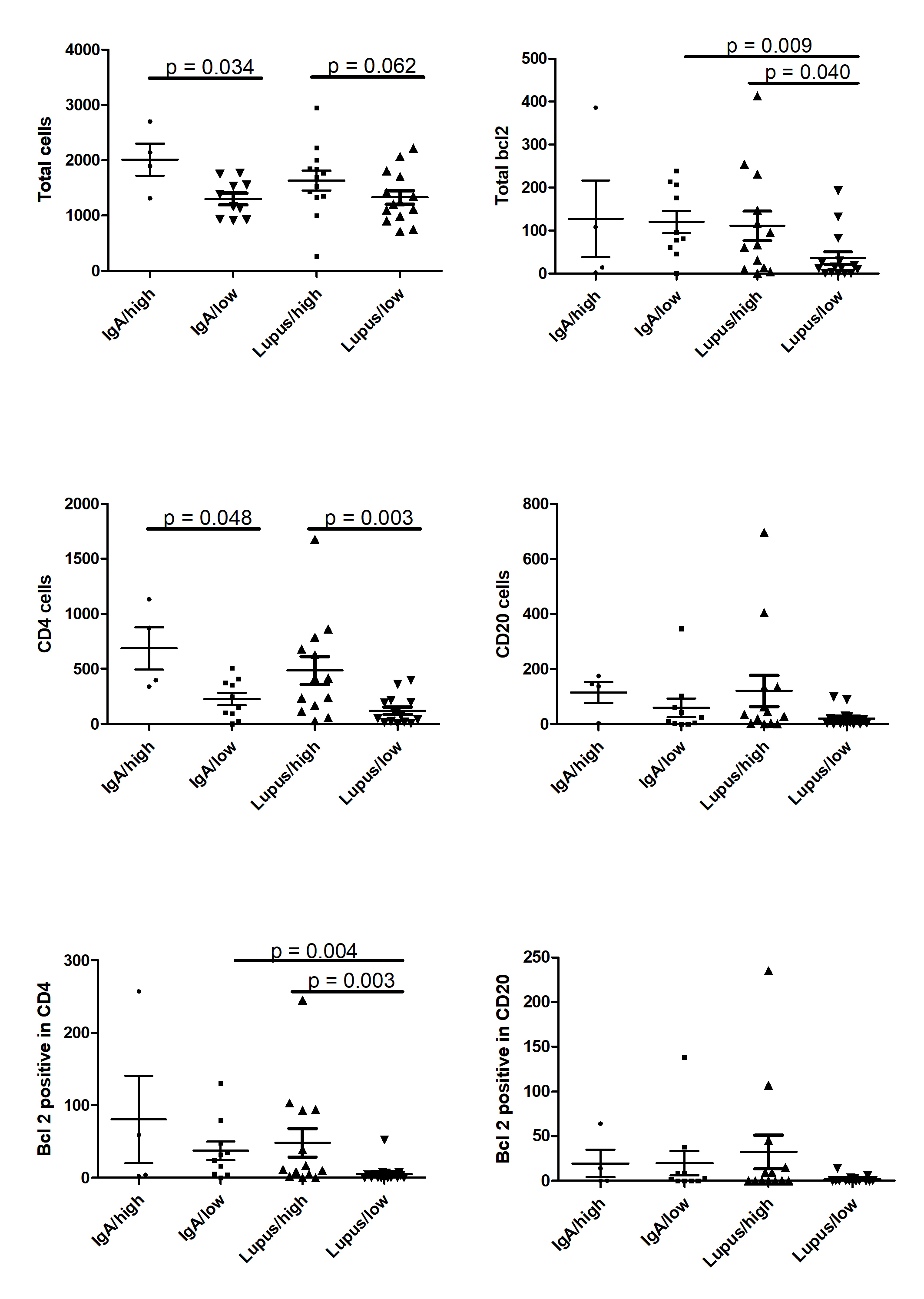Session Information
Date: Monday, November 9, 2020
Title: SLE – Diagnosis, Manifestations, & Outcomes Poster III: Bench to Bedside
Session Type: Poster Session D
Session Time: 9:00AM-11:00AM
Background/Purpose: Lupus nephritis is common clinical manifestation and contributes significantly to mortality in systemic lupus erythematosus (SLE).
Recently several studies has been reported that severity of tubulointerstitial inflammation (TII) is associated with subsequent renal failure. However, it has not yet been reported histologic characteristics and prognosis by extent of TII in patients with lupus nephritis who had conventional treatment.
Methods: Ninety-four patients with lupus nephritis, who had conventional treatment and renal biopsy, were enrolled in this study. The extent of tubulointerstitial lymphocytic infiltrates was semi-quantitated (grade 1-4) using standard histochemical staining. Quantified apoptotic regulator protein, the B cell lymphoma 2 protein (Bcl-2), expressions in selected lymphocyte subsets were measured using novel computational approaches when applied to multicolor confocal images. Histologic characteristics and prognosis as well as clinical and laboratory characteristics were compared between mild (grade 1-2) and severe (graded 3-4) TII. Follow-up datas were obtained and survival analysis was carried out to determine.
Results: TII was a common pathologic finding, 61.7% percent of biopsy samples were graded as 1, 13.8% as 2, 14.9% as 3, and 9% as 4. When TII was divided into mild (grade 1-2) and severe (grade 3-4), patients with severe TII were significantly higher in serum creatinine, but not with double-stranded DNA (ds DNA) antibodies, serum complement 3/4, SLE disease activity (SLEDAI) and degree of proteinuria at the time of biopsies. Expression of bcl-2 and bcl-2 in CD4 positive cells were significantly higher in severe TII compared to in mild TII in lupus nephritis (p=0.040 and p=0.003, respectively) while those were not significant in IgA vasculitis. The mean follow-up time was 150.3 ± 7.0 months and overall, 9 patients died as a result of disease progression (n=6) and infection (n=3). Patients with severe TII were at greater risk for renal failure compared to those with mild TII (p=0.001). However, both glomerular proliferation and laboratory markers including baseline ds DNA, complement, SLEDAI and degree of proteinuria did not affect on long term renal failure. After multivariate logistic analysis including age and sex, severe TII provided poor prognostic information for renal failure (hazard ratio 4.5, 95% confidence interval 1.4–14.5; p = 0.011).
Conclusion: A significantly higher elevated bcl-2, especially in CD4 positve cells, was found in severe TII compared to mild TII in lupus nephritis whereas there was comparable bcl-2 expression in IgA vasculitis irrespective of inflammation extent. TII severity was independent predictor for a worse outcome in lupus nephritis patients with conventional treatment.
To cite this abstract in AMA style:
Lee S, Nam E, Han M, Kim Y. The Extent of Tubulointerstitial Inflammation in Lupus Nephritis Identifies Two Distinctive Subgroups: Impact on Inflammation Characteristics and Prognosis in Patients with Lupus Nephritis [abstract]. Arthritis Rheumatol. 2020; 72 (suppl 10). https://acrabstracts.org/abstract/the-extent-of-tubulointerstitial-inflammation-in-lupus-nephritis-identifies-two-distinctive-subgroups-impact-on-inflammation-characteristics-and-prognosis-in-patients-with-lupus-nephritis/. Accessed .« Back to ACR Convergence 2020
ACR Meeting Abstracts - https://acrabstracts.org/abstract/the-extent-of-tubulointerstitial-inflammation-in-lupus-nephritis-identifies-two-distinctive-subgroups-impact-on-inflammation-characteristics-and-prognosis-in-patients-with-lupus-nephritis/

